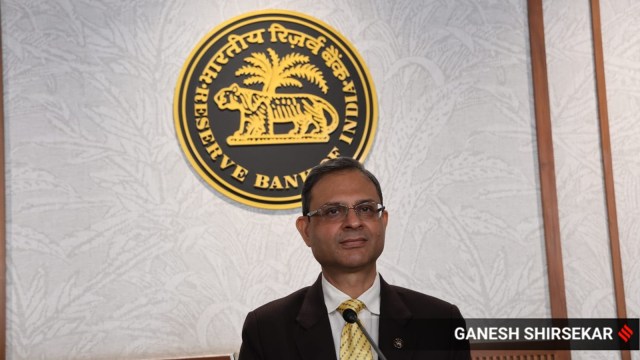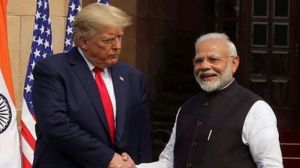Reserve Bank of India (RBI) Governor Sanjay Malhotra on Wednesday urged other central banks to use and promote Central Bank Digital Currencies (CBDCs) instead of stablecoins to facilitate international payments. Speaking at the annual meeting of the World Bank Group and International Monetary Fund (IMF) in Washington, DC, Malhotra also reiterated the Indian central bank’s stance on cryptocurrencies, saying their usage had implications for monetary policy, capital account flows, and money laundering.
“Unless other countries also adopt CBDC, we are not going to see the benefits of CBDC insofar as cross-border payments are concerned. So, I would urge all those present from central banks and other jurisdictions that we need to promote the CBDC, because this has huge advantages over stablecoins,” Malhotra said in a conversation with Krishna Srinivasan, the Director of the IMF’s Asia and Pacific Department.

“It is fiat (money), it has all the advantages of stablecoins, it can be tokenised…and (has) the advantages of singleness of money, the integrity of money. So, all of us need to promote that. Only then we will be able to actually roll it out at a large scale,” he added.
Story continues below this ad
The RBI is currently conducting pilot projects of two types of CBDCs – retail and wholesale. Malhotra said on Wednesday that with domestic payments not an issue in India, CBDCs were the answer for cross-border payments.
Malhotra’s comments come days after Finance Minister Nirmala Sitharaman seemingly suggested a shift in the government’s stance on stablecoins. Earlier this month at the Kautilya Economic Conclave, Sitharaman had said innovations such as stablecoins were transforming the landscape of money and capital flows and forcing countries to choose between adapting to new monetary architectures or risk being excluded.
“Such developments underscore the scale of the transformation underway. They also remind us that no nation can insulate itself from systemic change. Whether we welcome these shifts or not, we must prepare to engage with them,” the Finance Minister said on October 3 in New Delhi.
Rising acceptance of stablecoins
Sitharaman’s comments came at a time when stablecoins – which are essentially private cryptocurrencies linked to an actual asset, usually the US dollar – are seeing increasing acceptance among policymakers.
Story continues below this ad
In June, the US Senate passed the Guiding and Establishing National Innovation for US Stablecoins Act (GENIUS Act), while the Digital Asset Basic Act bill was introduced in South Korea’s National Assembly. Under this bill, domestic firms can issue their own stablecoins pegged to the South Korean won. In May, Hong Kong ‘s Legislative Council passed a stablecoin legislation to establish a licensing regime for local ‘fiat-referenced stablecoins’ issuers.
For governments, advancing stablecoins linked to national currencies is also being seen as a way to promote the international standing of their currency. “A thriving stablecoin ecosystem will drive demand from the private sector for US Treasuries, which back stablecoins. This newfound demand could lower government borrowing costs and help rein in the national debt,” US Treasury Secretary Scott Bessent posted on X on June 17, going on to add two days later that “stablecoins can reinforce dollar supremacy”.
At present, Tether and USDC are the top two stablecoins globally. Both are pegged to the US dollar and make up around 90 per cent of the $285 billion global stablecoin market.
The RBI has previously warned about the dangers of increased acceptance of US dollar-linked private cryptocurrencies, which could result in the dollarisation of the Indian economy – a situation where the US dollar becomes increasingly acceptable in the country and begins to substitute the rupee. This can lead to domestic policies not having their desired impact because the government or the RBI cannot control the supply of the US dollar.
‘Phenomenal’ economic growth
Story continues below this ad
Commenting on the Indian economy’s performance, Governor Malhotra said growth has been “phenomenal”. He went on to say there were upside risks to the RBI’s growth forecast of 6.8 per cent for the current fiscal year should the US tariff issue be resolved.
“We have in our projections actually taken into account the higher tariffs as the baseline. But negotiations are on. Even today, there is a team over here (to negotiate). So, I met the team in the morning over breakfast. They’re over here discussing with the US authorities.”
“India is mostly a domestic driven economy. While we are impacted by the higher tariffs, it’s not a matter of huge concern. 6.8 per cent, of course, is much below our aspirational levels of growth… But yes, there will be an upside if we are able to have an early resolution to the tariffs,” he added.
India’s higher-than-expected growth rate of 7.8 per cent in the April-June quarter has led to an upgrade in forecasts for the current year that will end in March 2026, with the World Bank and IMF both raising their GDP growth forecasts for India for the current year by 20 basis points (bps) this month to 6.5-6.6 per cent. However, with the US levying a total tariff of 50 per cent on Indian goods, risks are seen to next year’s growth. As such, the two multilateral organisations also cut their forecasts for India’s growth next year by 20 bps to 6.2-6.3 per cent.




![Kadapa, [Andhra Pradesh], 27 May (ANI): Andhra Pradesh Chief Minister N Chandrababu Naidu and state Minister Nara Lokesh in conversation during the Telugu Desam Party's (TDP) annual three-day Mahanadu conclave, in Kadapa on Tuesday. (ANI Photo)](https://images.indianexpress.com/2025/05/tdp.jpg?w=400)





![Kadapa, [Andhra Pradesh], 27 May (ANI): Andhra Pradesh Chief Minister N Chandrababu Naidu and state Minister Nara Lokesh in conversation during the Telugu Desam Party's (TDP) annual three-day Mahanadu conclave, in Kadapa on Tuesday. (ANI Photo)](https://images.indianexpress.com/2025/05/tdp.jpg?w=300)






















